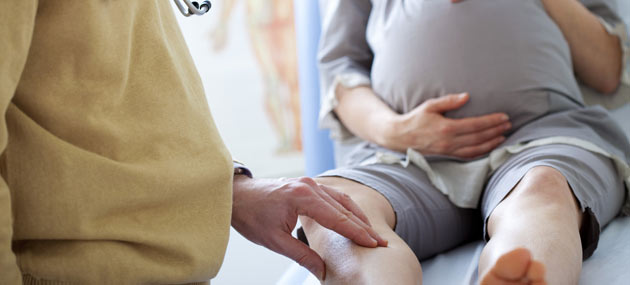
Varicose Veins in Pregnancy
Why the Likelihood of Varicose Veins Can Be Increased in Pregnancy?
During pregnancy, the mother’s body undergoes a series of natural physiological changes that provide conditions for better fetal development. Some of these changes may have unwanted side-effects on mother’s health. One of the common complaints among pregnant women is both the vasodilatation and appearance of the rope-like veins or varicose veins in the legs. About a third of the pregnant women experience varicose veins. The followings are among physiological changes making such a problem in pregnancy:
- The Upsurge of Progesterone Hormone: The blood level of this hormone increases as pregnancy progresses. Among its performances are loosening and dilating of the veins and Pigeonhole valves. This causes both the slow movement of the blood in the legs and the accumulation of blood in the veins of the leg causing varicose veins and increasing risk of blood clots in the leg.
- The Incensement of Circulation Volume: The amount of blood circulating during pregnancy increases to 50% in order to meet the growing needs of the developing fetus, which in turn increases the volume of blood in the veins of the leg.
The Enlarged Uterus: As the fetus develops and the uterus dilates, more pressure goes to the blood vessels from the heart to the legs or vice versa. This pressure prevents the blood flow from the bloodstream and causes blood to accumulate in the vein.
There are some strategies to prevent the varicose veins or its exacerbation in the pregnant women; such women are advised to follow those strategies to have a healthy pregnancy.
Consult with Your Doctor
1) If you decide to become pregnant, be sure to consult with your specialist doctor and check your feet vascular health if you have had a varicose vein in your previous pregnancy or a family history of varicose veins.
2) Regarding the desired weight gain during pregnancy and the recommended weight gain pattern, consult with your nutritionist or gynecologist during various months of pregnancy. Maintaining optimal weight and avoiding excessive weight gain can moderate pressure on the veins.
3) If you are advised by a doctor or an obstetrician to give yourself bed rest, be sure to consult with them regarding wearing compression socks to prevent the onset of a clot in the leg.
Strengthening the Circulation: a Key to Prevent the Intravenous Problems during Pregnancy
1) Following a regular exercise program to improve blood circulation and help strengthening the blood flow in the organs is recommended to the pregnant women. At the moment, fast walking for about 20 to 30 minutes and having suitable exercises to the mother`s conditions are recommended.
2) Putting the Legs up: Putting the legs up the wall and in fact above the heart surface for several times in a day, each time for about 10 to 15 minutes can help mothers.
3) Lying to the Left Side during Sleep: In this case, the lowest pressure in the abdominal environment is felt on the vessels and the blood flow to the heart is facilitated. It is better for the mother to sleep on the left side while sleeping and use a pillow between her knees and feet to minimize the pressure on the legs.
4) The Consumption of Vitamin C, E and A in a daily diet can be beneficial for maintaining the health of the arteries.
5) Do not cross your legs while sitting.
6) Avoid standing up and sitting for a long time without moving or changing your body position.
7) Change your body position at least every 30 to 45 minutes to help improve the blood flow.
8) Use constipation prevention recommendations during pregnancy. Constipation is one of the physiological complications of pregnancy that can be accompanied by the increased pressure on the vessels and the occurrence of constipation.
Compression Socks: a Memorable Friend during Pregnancy
Nowadays, there are various types of compression socks for the pregnant women; such women can prevent leg swelling and pain by wearing them during pregnancy; they can also help leg veins to maintain their elasticity and return to their initial state of the postpartum. The best time to wear socks is in the morning before getting out of bed; they can be worn during the day.
Take Away Your Concern!
The appeared varicose veins in most women would be significantly disappeared six months after the childbirth. But the likelihood of such a pleasant change would be reduced in mothers with both frequent pregnancies and a short interval between pregnancies. In either case, if varicose veins are not disappeared in six months after delivery, they would need to be investigated by a specialist doctor in order to prevent their unwanted complications; medical treatments should be taken as well. In addition, if you have experienced varicose veins during your pregnancy and are planning to become pregnant again, consult with your specialist doctor before taking any action.
This essay is translated by Mojgan Salmani
